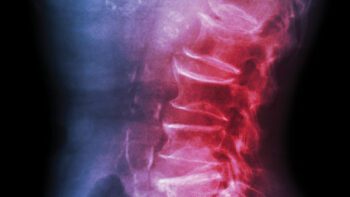
Back Story
The beginning and end of my story is no different from many of those I’ve read in “SpineTales.” Degenerative disc disease of my lumbar spine had progressed to the point where surgical intervention was necessary and I now live a full life completely free of back pain. What I want to convey in this story is the importance of educating yourself about your condition and possible treatments, the importance of appreciating the advances in surgical technology and expertise that are available, and the importance of being grateful for the possibility of living your life fully again.
Lower back pain flared up occasionally throughout all of my adult life, typically following some type of activity that strained my lower back. My first nasty back pain came at age 19 after simply chopping wood in my parents’ backyard. Episodes like this continued intermittently for the next 30 years, usually every six months. For treatment, I would rest or take ibuprofen and acetaminophen and the pain would go away in a couple of weeks. Looking back, I vividly remember my dad dealing with back pain and I remember stories of my grandfather’s back pain being so bad that he was occasionally hospitalized.
Treatment & Recovery
In the summer of 2011, my spine health began to decline with a progression of new and more severe symptoms. With agonizing and constant pain in my hip, I made a visit to an orthopedic surgeon who ordered an MRI of my hip, showing nothing amiss. A subsequent MRI of the lumbar spine showed a herniated L4-L5 disc and a prevalent bulge of the L5-S1 disc. Physical therapy was prescribed, which I diligently completed. By September 2011, I was relatively pain free.
Fortunately, we live at a time when diagnostic imaging studies are conducted at specialty facilities and patients are the custodians of their own study media. We take MRIs with us to our office visits, but we can also load the imagery onto our own computers and view the same images our surgeons examine while they diagnose our problem. As I was recovering from my disc herniation, I poured over my MRIs and did an initial bit of internet research in an attempt to learn what was wrong with my spine and why I kept having recurring back pain incidents. It was easy to find very informative videos, spine condition descriptions, and treatments at a number of highly reputable web sources. Given the extent of information available, I was able to become appreciably informed about my condition and options.
In February 2012, I was catching curve balls from my daughter (a committed NCAA Division I softball pitcher) when all of the pain came back immediately, with additional excruciating pain located just above my sacroiliac joint. I was miserable and went to see the orthopedic surgeon again. After another MRI of my lumbar spine, it appeared that the L4-L5 disc had emitted more material, and my orthopedic surgeon recommended a microdiscectomy of the L4-L5 disc. I underwent the procedure and immediately felt complete relief. Unfortunately, this feeling only lasted for three months.
Pain returned for no apparent reason in May 2012 and worsened daily. At the time, I was thinking that I would need an additional microdiscectomy, and I made another visit to the orthopedic surgeon’s office. From August 2012 through February 2013, I was given several sets of steroid injections, four facet joint rhizotomies, a lumbar CT scan (from which I was able to generate a 3D model of my spine), a nuclear bone scan, an EMG, an MRI of my thoracic spine, and an additional MRI of my lumbar spine. The pain reached a level that was nearly impossible to bear. I was using two canes because I couldn’t walk more than 20 feet on my own, I was taking maximum recommended doses of several opiates, I couldn’t sleep, nerve pain constantly shot down my legs, and I had extensive trouble just staying upright. If I were a horse, they would have shot me.
During this time, I again focused my attention toward my imaging studies and internet research. In addition to reviewing my MRIs and CT scans, studying the radiologist reports, and searching for MRI images of lumbar spine problems, I did the hard homework. I conducted extensive internet research to gain a basic understanding of spinal health vocabulary, nerve anatomy, surgical interventions, surgical indications (and contraindications), and non-invasive treatment options. Through my diligence and desperation, I had learned more about the spine, spine disorder diagnosis, and surgical options than I ever thought possible.
More importantly, though, I became a well-informed advocate for my own health.


